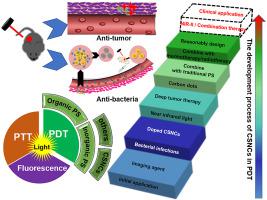当前位置:
X-MOL 学术
›
Prog. Nat. Sci. Mater. Int.
›
论文详情
Our official English website, www.x-mol.net, welcomes your
feedback! (Note: you will need to create a separate account there.)
Colloidal semiconductor nanocrystals for biological photodynamic therapy applications: Recent progress and perspectives
Progress in Natural Science: Materials International ( IF 4.8 ) Pub Date : 2020-08-01 , DOI: 10.1016/j.pnsc.2020.08.016 Dong Wang , Yibin Zhu , Xiaodong Wan , Xiaowei Zhang , Jiatao Zhang
Progress in Natural Science: Materials International ( IF 4.8 ) Pub Date : 2020-08-01 , DOI: 10.1016/j.pnsc.2020.08.016 Dong Wang , Yibin Zhu , Xiaodong Wan , Xiaowei Zhang , Jiatao Zhang

|
Abstract Photodynamic therapy (PDT), due to the high level of reactive oxygen species (ROS) and induced oxidative damage to proteins, lipids, DNA, and dysfunctions in cell metabolism, has exhibited its potential applications in anti-tumor and anti-bacteria biological applications. Photosensitizers (PS) are very necessary to achieve high PDT efficiency. Colloidal semiconductor nanocrystals (CSNCs) are increasingly utilized as emerging photosensitizers and adjuvants in PDT. They have many optical and chemical advantages such as narrow, symmetric and size-tunable emission spectra, stable fluorescence, broad absorption spectra, high level of brightness and photostability, large stokes shift, and easily functionalized with biological groups or molecules. Therefore, great interests have been received for CSNCs in constructing a PDT platform for cancer and bacterial behavior study even having the possible side effects, for example, the excitation light is mostly concentrated in the ultraviolet region, and the toxicity mechanism is not clear. This review mainly focuses on the recent progress of CSNCs-based PDT research for cancer cells and bacterial cells killing both in vivo and in vitro. From the perspective of the efficiency of PDT, the medicine, materials science and nanotechnology, as well as the representative works are summarized, and CSNCs with special functions are discussed. This review emphasized on the relationship between structure/composition and performance of PDT-based CSNCs. Meanwhile, the critical and potential issues and future perspectives are also addressed.
中文翻译:

用于生物光动力治疗应用的胶体半导体纳米晶体:最新进展和前景
摘要 光动力疗法 (PDT) 由于高水平的活性氧 (ROS) 和诱导蛋白质、脂质、DNA 的氧化损伤和细胞代谢功能障碍,在抗肿瘤和抗菌生物方面具有潜在的应用价值。应用程序。光敏剂 (PS) 对于实现高 PDT 效率非常必要。胶体半导体纳米晶体 (CSNC) 越来越多地用作 PDT 中的新兴光敏剂和佐剂。它们具有许多光学和化学优点,例如窄、对称和尺寸可调的发射光谱、稳定的荧光、宽吸收光谱、高亮度和光稳定性、大斯托克斯位移,以及易于与生物基团或分子进行功能化。所以,CSNCs在构建用于癌症和细菌行为研究的PDT平台方面受到了极大的关注,即使可能存在副作用,例如激发光主要集中在紫外区,并且毒性机制尚不清楚。本综述主要关注基于 CSNCs 的 PDT 研究在体内和体外杀伤癌细胞和细菌细胞的最新进展。从PDT效率的角度,总结了医学、材料科学和纳米技术及其代表著作,讨论了具有特殊功能的CSNCs。本综述强调了基于 PDT 的 CSNC 的结构/组成与性能之间的关系。同时,还讨论了关键和潜在的问题以及未来的前景。
更新日期:2020-08-01
中文翻译:

用于生物光动力治疗应用的胶体半导体纳米晶体:最新进展和前景
摘要 光动力疗法 (PDT) 由于高水平的活性氧 (ROS) 和诱导蛋白质、脂质、DNA 的氧化损伤和细胞代谢功能障碍,在抗肿瘤和抗菌生物方面具有潜在的应用价值。应用程序。光敏剂 (PS) 对于实现高 PDT 效率非常必要。胶体半导体纳米晶体 (CSNC) 越来越多地用作 PDT 中的新兴光敏剂和佐剂。它们具有许多光学和化学优点,例如窄、对称和尺寸可调的发射光谱、稳定的荧光、宽吸收光谱、高亮度和光稳定性、大斯托克斯位移,以及易于与生物基团或分子进行功能化。所以,CSNCs在构建用于癌症和细菌行为研究的PDT平台方面受到了极大的关注,即使可能存在副作用,例如激发光主要集中在紫外区,并且毒性机制尚不清楚。本综述主要关注基于 CSNCs 的 PDT 研究在体内和体外杀伤癌细胞和细菌细胞的最新进展。从PDT效率的角度,总结了医学、材料科学和纳米技术及其代表著作,讨论了具有特殊功能的CSNCs。本综述强调了基于 PDT 的 CSNC 的结构/组成与性能之间的关系。同时,还讨论了关键和潜在的问题以及未来的前景。











































 京公网安备 11010802027423号
京公网安备 11010802027423号